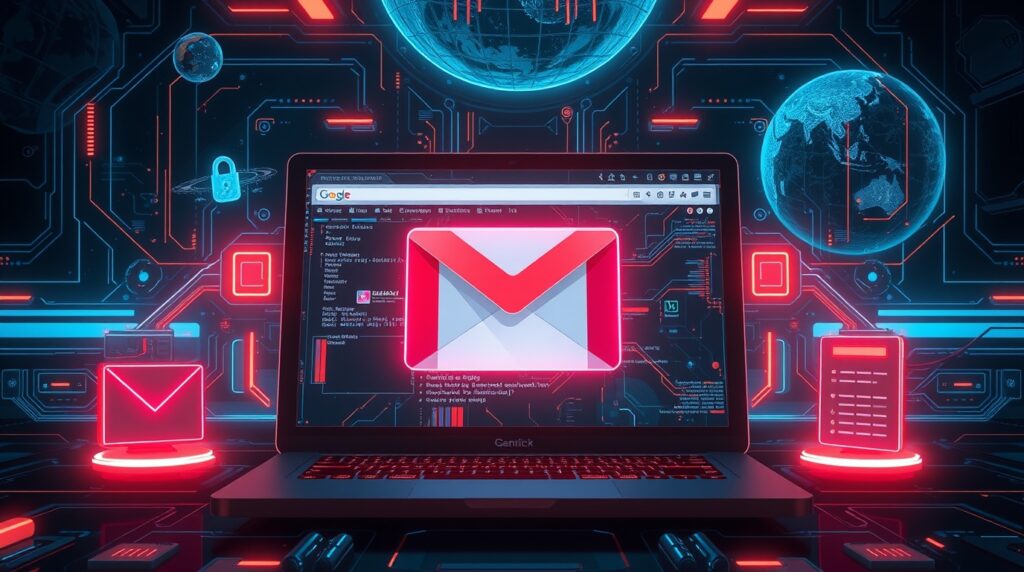
Picture this: You get an email that looks exactly like it’s from your bank. The logo’s perfect, the grammar’s flawless, and it’s urging you to click a link to “secure your account.” But here’s the kicker—it’s fake. “Gmail sophisticated attacks.”.Crafted by hackers using AI tools, these scams are why 1 in 4 people fall for phishing attacks. Gmail’s 1.8 billion users make it a playground for cybercriminals, and their tactics in 2024 are scarily clever. Let’s unpack what’s happening and how to fight back.
Why Your Gmail Is a Target (and What Hackers Want)
Hackers aren’t just after your cat photos. They want passwords, credit card details, and access to your contacts for bigger scams. Google’s latest stats show phishing attempts jumped 47% last year, with attacks getting sneakier. Here’s what’s driving the chaos:
- AI tools like ChatGPT churn out convincing fake emails.
- Cookie theft lets hackers skip passwords entirely.
- Deepfake audio mimicking your boss to approve fake payments.
Let’s break down the 7 biggest threats—and how to shut them down.

1. The “Too Good to Be Real” Phishing Email
What’s New: Forget typos and blurry logos. Hackers now use AI to write emails that mirror your bank, Amazon, or even your coworker. I recently got one pretending to be Google threatening to “suspend my account” unless I clicked a link. The site looked identical to the real login page.
How to Spot It:
- Hover over links—does the URL match the sender’s brand?
- Check for odd urgency (“ACT NOW OR LOSE ACCESS!”).
Pro Tip: Enable Gmail’s “Enhanced Safe Browsing” (Settings > Security). It’s like a bouncer for shady links.
2. MFA “Push Spam” Attacks
The Trick: Hackers bombard your phone with approval requests (e.g., “Did you log in from Russia?”). After 10+ alerts, you might accidentally hit “Yes” just to make it stop.
Why It Works: Microsoft says 34% of MFA users cave to “push fatigue.”
Fix It Fast: Ditch SMS codes. Use Google Authenticator or a $25 YubiKey—it’s a USB stick that blocks these attacks.
3. Malware Disguised as Cloud Files
The Bait: “Your invoice is attached!” emails with Google Drive links. The file? A ZIP folder hiding malware like Lumma Stealer, which vacuums your passwords.
Red Flags:
- “Password-protected” files (why would a legit invoice need one?).
- Messages from unknown senders about “missed deliveries.”
Do This: Right-click the file and scan it with VirusTotal before opening.
4. Cookie Hijacking: The Silent Account Takeover
How It Works: If malware like RedLine Stealer infects your laptop, it steals browser cookies. Hackers then use those cookies to waltz into Gmail—no password needed.
Real Damage: A major company’s CFO lost $500K this way in 2023.
Stop It: Log out of Gmail when done, and enable Google’s Advanced Protection Program.
5. Fake “App Permissions” Scams
The Trap: You download a “free PDF converter” that asks for Gmail access. Once you approve, hackers read every email you send.
Google’s Fix: They blocked 3,000+ shady apps last quarter.
Your Move: Prune app permissions monthly at myaccount.google.com/permissions. Delete anything you don’t recognize.
6. Deepfake Bosses in Your Inbox
The Horror Story: A finance employee wired $2.5M after a “video call” with their CEO—except it was an AI deepfake.
Defense: Always confirm big requests with a phone call. If your boss says “I emailed you,” call them back.
7. Zero-Day Exploits in Plugins
The Risk: Hackers exploit bugs in Chrome extensions or Google Calendar to slip malware into your inbox.
Recent Example: A 2023 Chrome flaw (CVE-2023-2033) let attackers hijack accounts via calendar invites.
Stay Safe: Update browsers weekly and nuke unused extensions.
5 No-Brainer Habits to Protect Your Gmail
- Lock it Down: Turn on Google’s Advanced Protection Program (needs a security key).
- Be a Skeptic: If an email feels “off,” it probably is. Trust your gut.
- Check Logins: Peek at myaccount.google.com/security-checkup monthly.
- Encrypt Sensitive Stuff: Use Proton Mail for financial or medical emails.
- Backup Everything: Save critical emails to an external drive—ransomware can’t touch it.
Final Word: Stay Paranoid (In a Good Way)
Hackers thrive on complacency. The second you think, “This won’t happen to me,” you’re a target. Keep your guard up, update your apps, and double-check every sketchy email. For more tips, follow Krebs on Security—they’re the watchdog of the cyber world.
Quick FAQ
Q: How do I know if my Gmail’s hacked?
A: Check for weird-sent emails, new filters you didn’t create, or logins from Timbuktu.
Q: Is SMS 2FA safe?
A: Nope. SIM swapping is rampant. Use an authenticator app or security key.
Q: Can hackers bypass Google’s spam filters?
A: Sometimes. Always report phishing (click the “Report” button in Gmail).


